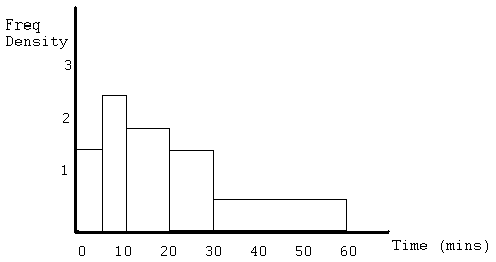

I'm doing GCSE Higher level. Can you explain what frequency density is? I keep seeing it in past exam papers but I'm sure we haven't done it in class. |
Frequency density needs to be calculated when drawing histograms, especially ones for data with unequal class widths.
You will usually have the data in the form of a grouped frequency distribution, which is a table showing the data classes and the frequency (the number of data values) in each class.
First calulate the width of each class, which is the difference between the upper and
lower class bounds. Then calculate the frequency density of each class. This is calculated
by the formula:

This is best presented in a table. For example:
| Time (mins) | Frequency | Class Width | Frequency Density |
|---|---|---|---|
| 0 - 5 | 7 | 5 | 1.4 |
| 5 - 10 | 12 | 5 | 2.4 |
| 10 - 20 | 18 | 10 | 1.8 |
| 20 - 30 | 14 | 10 | 1.4 |
| 30 - 60 | 15 | 30 | 0.5 |
The histogram must be drawn by plotting the frequency density up the vertical axis:

The important thing about using the frequency density to plot the histogram is that the area of the bars will be equal to the actual frequency of the classes.